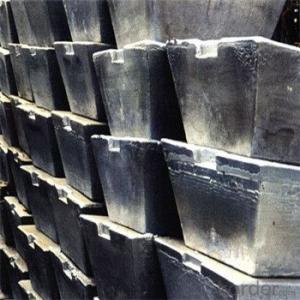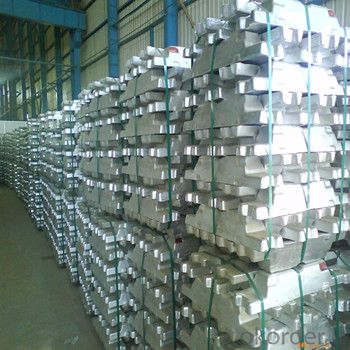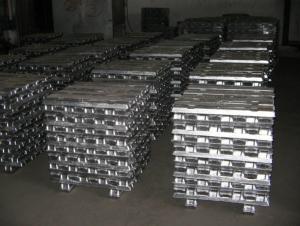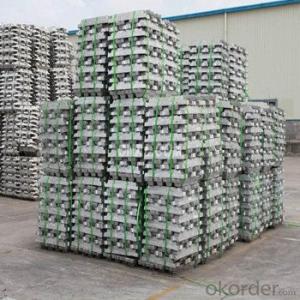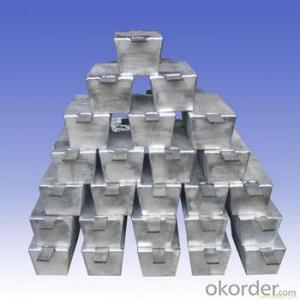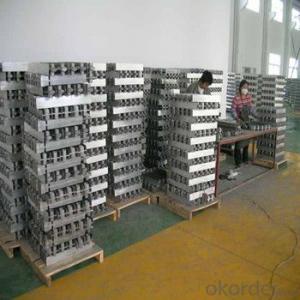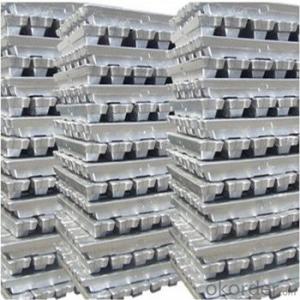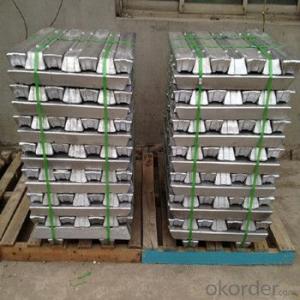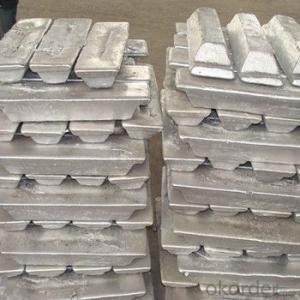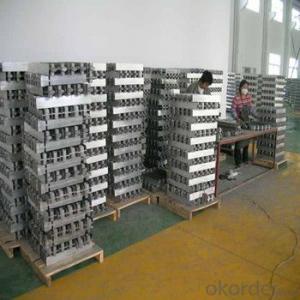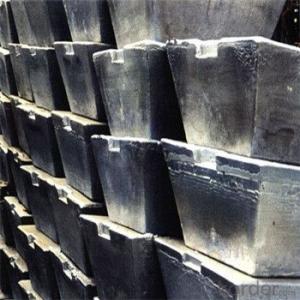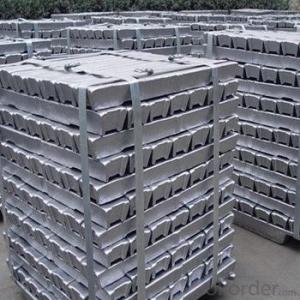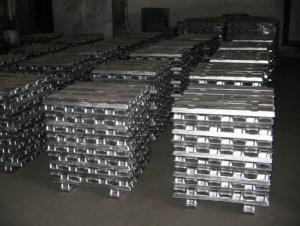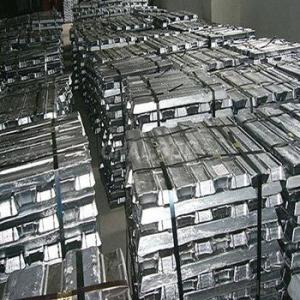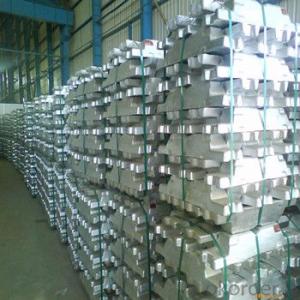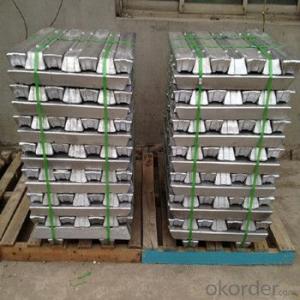Aluminum Pig/Ingot With Pime Grade With Competitive Price
- Loading Port:
- China main port
- Payment Terms:
- TT OR LC
- Min Order Qty:
- 1000 m.t.
- Supply Capability:
- 100000 m.t./month
OKorder Service Pledge
OKorder Financial Service
You Might Also Like
Pure Aluminum Pig/Ingot Used for Industry
1.Structure of Aluminum Pig/Ingot
A material that has been cast into a shape in order to be transported and processed easier than in an unprocessed form. An ingot is typically rectangular in shape, which allows it to be stacked. Ingots are most commonly associated with metals, with ingots of gold held in the vaults of banks and brokerages being popular images.
Aluminum Ingot is with the AL as the main chemical composition.Aluminum Ingot is used for industry,such as automobile,pinning and weaving,electron broadly and so on. Aluminum Ingot has the following advantages: easy control and operation, fast melting.
2.Main Features of the Aluminum Pig/Ingot
•High Purity
•Easy control and operation
•High strength
•Fast melting
•Competitive price
•Best Service
3.Aluminum Pig/Ingot Images

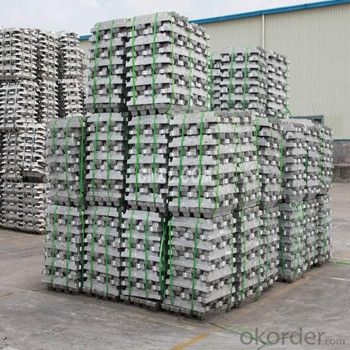
4.Aluminum Pig/Ingot Specification
Grade | Chemical Composition % | |||||||||
Al≥ | impurities ≤ | |||||||||
Si | Fe | Cu | Ga | Mg | Zn | Mn | others | Sum | ||
Al99.9 | 99.90 | 0.50 | 0.07 | 0.005 | 0.02 | 0.01 | 0.025 | - | 0.010 | 0.10 |
Al99.85 | 99.85 | 0.80 | 0.12 | 0.005 | 0.03 | 0.02 | 0.030 | - | 0.015 | 0.15 |
Al99.7 | 99.70 | 0.10 | 0.20 | 0.010 | 0.03 | 0.02 | 0.030 | - | 0.030 | 0.30 |
Al99.6 | 99.60 | 0.16 | 0.25 | 0.010 | 0.03 | 0.03 | 0.030 | - | 0.030 | 0.40 |
Al99.5 | 99.50 | 0.22 | 0.30 | 0.020 | 0.03 | 0.05 | 0.050 | - | 0.030 | 0.50 |
Al99.00 | 99.00 | 0.42 | 0.50 | 0.020 | 0.03 | 0.05 | 0.050 | - | 0.050 | 1.00 |
5.FAQ of Aluminum Pig/Ingot
We have organized several common questions for our clients,may help you sincerely:
①How about your company?
A big and famous and professional manufacturer & supplier of Aluminum Pig/Ingot, is one of the one of the large-scale professional investment Aluminum Pig/Ingot production bases in China.It have focuses on producing the Aluminum Pig/Ingot production for many years and gotten rich experience.Annually lagrge amount of Aluminum Pig/Ingot production are exported to markets in Europe,America and Japan. The quality and service have also gotten OEM service is available according to customer’s requirements.
②How to guarantee the quality of the products?
We have established the international advanced quality management system,every link from raw material to final product we have strict quality test;We resolutely put an end to unqualified products flowing into the market. At the same time, we will provide necessary follow-up service assurance.
③How long can we receive the product after purchase?
In the purchase of product within three wo We have organized several common questions for our clients,may help you sincerely:
①How about your company?
A big and famous and professional manufacturer & supplier of Aluminum Pig/Ingot, is one of the one of the large-scale professional investment Aluminum Pig/Ingot production bases in China.It have focuses on producing the Aluminum Pig/Ingot production for many years and gotten rich experience.Annually lagrge amount of Aluminum Pig/Ingot production are exported to markets in Europe,America and Japan. The quality and service have also gotten OEM service is available according to customer’s requirements.
②How to guarantee the quality of the products?
We have established the international advanced quality management system,every link from raw material to final product we have strict quality test;We resolutely put an end to unqualified products flowing into the market. At the same time, we will provide necessary follow-up service assurance.
③How long can we receive the prod rking days, We will arrange the factory delivery as soon as possible. The pecific time of receiving is related to the state and position of customers.Commonly 7 to 10 working days can be served.
- Q: What are the different surface treatment options for aluminum ingots?
- There are several surface treatment options available for aluminum ingots, depending on the desired outcome and application. Some of the commonly used surface treatment options for aluminum ingots include anodizing, powder coating, polishing, and painting. Anodizing is a popular surface treatment method for aluminum ingots. It involves creating a protective oxide layer on the surface of the aluminum through an electrochemical process. Anodizing provides various benefits such as increased corrosion resistance, improved durability, and enhanced aesthetic appearance. It also allows for coloring options by dyeing the oxide layer. Powder coating is another surface treatment option for aluminum ingots. It involves applying a dry powder coating to the surface of the aluminum and then curing it in an oven. The powder adheres to the surface electrostatically and creates a durable and protective layer. Powder coating offers excellent resistance to impacts, chemicals, and weather conditions. It is available in a wide range of colors and finishes. Polishing is a surface treatment method that involves smoothing and shining the surface of aluminum ingots. It is achieved by using abrasive materials and techniques to remove any imperfections, scratches, or dullness. Polishing enhances the aesthetic appearance of aluminum, giving it a mirror-like or satin finish. Painting is a surface treatment option that involves applying a liquid paint coating to the surface of aluminum ingots. It can provide both protection and decoration. Painting allows for a wide range of colors and finishes, providing flexibility in design and customization. It is commonly used for architectural applications, outdoor furniture, and automotive parts. In addition to these surface treatment options, aluminum ingots can also undergo other treatments like brushing, sandblasting, and etching. These methods can offer unique finishes and textures to the aluminum surface, depending on the specific requirements of the application. Overall, the choice of surface treatment for aluminum ingots depends on factors such as the desired appearance, functionality, and the environment in which the aluminum will be used. Each treatment option has its own advantages and considerations, so it is essential to carefully evaluate the requirements before selecting the most appropriate surface treatment method.
- Q: How much is each ton of aluminium ingot and stainless steel ingot?
- If the condition permits, put the gold on the fire, if has not changed color for a period of time, is really, has changed the color is false!
- Q: How do aluminum ingots contribute to the circular economy?
- Aluminum ingots play a significant role in contributing to the circular economy due to their recyclability and multiple applications. The circular economy is an economic system aimed at minimizing waste and maximizing the value of resources by promoting reuse, recycling, and remanufacturing. One key aspect of aluminum ingots is their recyclability. Aluminum is one of the most recycled materials globally, with a recycling rate of around 70-80%. This means that a large portion of aluminum used in various products can be recycled and transformed into new aluminum ingots. This recycling process requires significantly less energy compared to primary aluminum production, resulting in reduced greenhouse gas emissions and a lower environmental footprint. Moreover, aluminum ingots have numerous applications across various industries, including construction, automotive, aerospace, packaging, and electronics. By using recycled aluminum ingots, these industries can reduce their dependence on virgin (primary) aluminum extraction, which is an energy-intensive process. The use of recycled aluminum ingots not only conserves natural resources but also helps in reducing carbon emissions associated with primary aluminum production. Additionally, the circular economy approach encourages the design and production of products with recyclability in mind. Aluminum ingots can be easily melted down and reshaped into various forms, allowing for the creation of new products while maintaining their quality. This closed-loop system ensures that aluminum remains in circulation, reducing the need for raw material extraction and minimizing waste generation. In conclusion, aluminum ingots contribute to the circular economy by being highly recyclable, enabling the transformation of waste aluminum into valuable resources. Their use in various industries promotes sustainability, reduces energy consumption, and minimizes waste, making aluminum ingots an essential component in the transition to a more circular and resource-efficient economy.
- Q: The difference between pure aluminium ingot and aluminium alloy ingotToday I know, aluminum ingot is also divided into pure aluminum ingot, aluminum alloy ingot, what is the difference between them?
- Pure aluminium ingot: Aluminum exists in the surface, in addition to iron (Fe) in ranking the second metal elements, since the electrolysis method was invented, human made from bauxite surface, refining of high purity (more than 99.7%) for pure aluminum, aluminum ingots. Such as direct casting for casting toughness is good but not with strength, poor physical properties.
- Q: How are aluminum ingots used in the production of marine vessels?
- The production of marine vessels heavily relies on aluminum ingots, which fulfill a crucial role. These ingots serve as the primary raw material for constructing different components and structures of the vessel, including the hull, superstructure, and other parts. The outstanding strength-to-weight ratio of aluminum ingots is one of the main reasons why they are preferred for marine vessel production. Being a lightweight metal, aluminum offers exceptional structural integrity, making it an ideal choice for building durable and agile vessels. Shipbuilders can utilize aluminum ingots to create robust and fuel-efficient vessels, resulting in improved performance and reduced operating costs. Additionally, aluminum ingots possess a high resistance to corrosion, which is a significant advantage in the marine environment. Traditional steel vessels are prone to severe corrosion caused by saltwater and harsh weather conditions, leading to maintenance issues and a shortened lifespan. The natural corrosion resistance of aluminum minimizes the need for extensive maintenance, ensuring the longevity of the vessel. Moreover, aluminum ingots are easy to work with and offer excellent formability. Shipbuilders can mold, bend, weld, and shape them into intricate designs required for marine vessel production. This flexibility allows for the creation of complex structures and optimization of the vessel's overall design, enhancing both performance and aesthetics. Furthermore, the use of aluminum ingots in marine vessel construction contributes to sustainability efforts. Aluminum is a highly recyclable material, and incorporating recycled aluminum in the production process significantly reduces energy consumption and greenhouse gas emissions. This aligns with the increasing emphasis on eco-friendly practices in the maritime industry. In conclusion, aluminum ingots are an indispensable component of the marine vessel production process. Their lightweight nature, strength, corrosion resistance, formability, and recyclability make them an excellent choice for constructing vessels that are efficient and sustainable.
- Q: What are the advantages of using recycled aluminum ingots?
- There are several advantages of using recycled aluminum ingots. Firstly, recycling aluminum saves energy as it requires significantly less energy to produce recycled aluminum compared to virgin aluminum. This helps in reducing greenhouse gas emissions and mitigating climate change. Secondly, using recycled aluminum ingots reduces the need for mining and extraction of bauxite, the primary raw material for aluminum production, thereby conserving natural resources. Additionally, recycling aluminum helps in reducing landfill waste and promotes a circular economy by reusing materials instead of disposing them. Lastly, recycled aluminum ingots exhibit the same quality and performance as virgin aluminum, making them a sustainable and cost-effective alternative for various industries.
- Q: How much is the power consumption to smelt a ton of aluminium ingot?
- Plus you want to formula to aluminum alloy brand, higher temperature, and insulation process, estimated 700-800 degrees of electricity; processing into aluminum plate must be 1000 degrees electricity.
- Q: What are the advantages of using aluminum ingots in electrical applications?
- There are several advantages of using aluminum ingots in electrical applications. Firstly, aluminum is a lightweight material, which makes it easier to handle and transport. This property is particularly beneficial in electrical applications where weight is a concern, such as in the construction of power lines or in the manufacturing of electrical appliances. Secondly, aluminum has excellent electrical conductivity. It conducts electricity almost twice as well as copper, which is commonly used in electrical applications. This high conductivity allows for efficient transmission of electricity and reduces energy losses in electrical systems. Another advantage of aluminum ingots is their corrosion resistance. Aluminum forms a protective oxide layer when exposed to air, which helps to prevent corrosion. This makes aluminum suitable for use in outdoor electrical applications, where exposure to moisture or harsh weather conditions is common. Furthermore, aluminum is a highly recyclable material. It can be melted down and reused multiple times without losing its properties. This not only reduces the need for mining and extraction of new raw materials but also contributes to the sustainability of electrical applications. Lastly, aluminum ingots are cost-effective compared to other materials like copper or steel. Aluminum is abundant in nature and its extraction and processing are relatively less expensive, making it a more affordable option for electrical applications. Overall, the advantages of using aluminum ingots in electrical applications include their lightweight nature, high electrical conductivity, corrosion resistance, recyclability, and cost-effectiveness. These properties make aluminum a preferred choice in various electrical systems, contributing to improved efficiency, durability, and environmental sustainability.
- Q: What aluminum factories are there in Guangdong and Foshan?
- Cheap comparison, if the quality can price in the medium level, but can be at ease, is called a penny goods.
- Q: What are the advantages of using aluminum ingots in the production of automotive lightweighting solutions?
- There are several advantages of using aluminum ingots in the production of automotive lightweighting solutions. Firstly, aluminum is a lightweight material, which makes it ideal for reducing the overall weight of vehicles. By using aluminum ingots, manufacturers can significantly reduce the weight of various automotive components, such as body panels, engine parts, and structural elements. This reduction in weight leads to improved fuel efficiency, as lighter vehicles require less energy to accelerate and maintain speed. Additionally, it allows for better handling and maneuverability, enhancing the overall driving experience. Secondly, aluminum is a highly durable material that offers excellent strength-to-weight ratio. This means that even though it is lightweight, aluminum ingots provide sufficient strength and structural integrity to withstand the demands of everyday driving and ensure the safety of passengers. It can also resist corrosion, making it a suitable choice for automotive applications where exposure to harsh weather conditions or road salt is common. Another advantage of using aluminum ingots in automotive lightweighting is their versatility. Aluminum can be easily molded, shaped, and joined using various manufacturing techniques, allowing for the production of complex and intricate designs. This versatility allows manufacturers to create innovative automotive components that meet specific performance requirements without sacrificing weight reduction goals. Moreover, aluminum is a highly recyclable material, making it an environmentally friendly choice for automotive lightweighting solutions. The recycling process for aluminum consumes only a fraction of the energy required for primary production, resulting in fewer greenhouse gas emissions. This not only helps reduce the carbon footprint of the automotive industry but also promotes a more sustainable manufacturing process. Lastly, aluminum ingots offer cost advantages in the long run. While the initial production costs of aluminum components may be higher compared to traditional materials, such as steel, the overall lifecycle costs are often lower. The lightweight nature of aluminum reduces the demand on other vehicle systems, such as brakes and suspension, leading to potential savings in maintenance and replacement costs. Additionally, the recyclability of aluminum allows for the recovery and reuse of the material, reducing the need for new raw material extraction. In conclusion, the advantages of using aluminum ingots in the production of automotive lightweighting solutions include weight reduction, improved fuel efficiency, durability, versatility, environmental friendliness, and long-term cost savings. These benefits make aluminum a preferred choice for manufacturers aiming to enhance the performance, efficiency, and sustainability of modern vehicles.
Send your message to us
Aluminum Pig/Ingot With Pime Grade With Competitive Price
- Loading Port:
- China main port
- Payment Terms:
- TT OR LC
- Min Order Qty:
- 1000 m.t.
- Supply Capability:
- 100000 m.t./month
OKorder Service Pledge
OKorder Financial Service
Similar products
Hot products
Hot Searches
